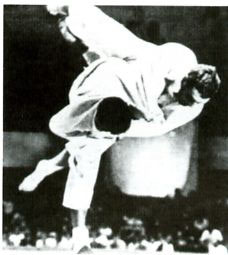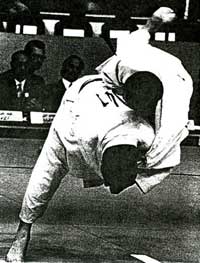Past and Present
By Jim Chen, M.D., and Theodore Chen
Shiro SaigoThe Inventor Of Yama-Arashi
In August 1883, Shiro Saigo (153 cm, 5 ft, 56 kg, 123 lbs) along with Tsune-jiro Tomita were the first judoka to obtain black belts. In 1888, at age 21, Saigo was also the first to obtain Go-dan. Saigo was born in 1867 in Nigata Prefecture, Japan. As a child, he wished to become an army general. However, due to his short stature, he was not allowed to enter the military academy. At age 14, he began practicing jiu-jitsu at Inouye Dojo (Jigoro Kano’s Sensei). Saigo was born with octopus toes (irregular shaped feet with long and curved toes) which improved his balance and made him very difficult to throw. One year later, Kano recruited Saigo to Kodokan to train. Beginning in October 1882, Saigo, Tomita, and Kano lived on a 12 mat dojo and practiced all day. He was promoted to Yon-Dan in 1885 and Go-Dan in 1888. Metropolitan Police Jiu-Jitsu Meet in 1886
The Tokyo Metropolitan Police Jiu-jitsu Meet was a tournament held to determine which martial art was superior in a true fight. The Jiu-jitsu group was skeptical of Kodokan Judo because Kano had only 5 years experience in Kito-ryu and Yoshin-ryu. It was sanctioned by Mr. Mi-shima, Chief of Police of Tokyo. Of the 9 matches between Judo and Jiu-jitsu, the Kodokan had 8 wins and one draw. The final match was between Saigo and Taro Terujima (27 years old, 171 cm, 5 ft 6 in, 83 kg, 183 lbs). It was a match that pitted two very different styles against each other. Terujima was large and powerful, but with less refined techniques. On the other hand, Saigo was a small, agile man with brilliant skill. Both fought with a left hand grip. Terujima controlled the initial 10 minutes of the battle with relentless attacks of Osoto-gari, Uchi-mata, and Harai-goshi. Frequently Saigo was seemingly overpowered and was thrown up in the air, but he always came down on his feet in a controlled manner. People compared Saigo’s movements to that of an agile cat. After 10 minutes Terujima grew tired and Saigo quickly counterattacked with his Ouich-gari, but in vain. About 15 minutes into the fight Terujima rushed in to overpower Saigo. At the same time Saigo perfectly executed his trademark Yama-Arashi, which threw Terujima with such force that he retired with a concussion. In 1889 Saigo’s reign with Kodokan came to an end when he participated in a “Pit Bull” fighting contest. Here he fought a 197cm, 6’6, 140kg, 308lbs, sumo wrestler name Ara-umi. During the duel Saigo punched Ara-umi in the chest, a blow which later proved fatal. Saigo was removed from Kodokan after the death. Later in his life, Saigo became a journalist and was active in politics in China. He became a political advisor to Dr. Sun Yat-Sen (Founder of Rep. of China). In 1922 Saigo died a Rokudan at age 57. Yoshitsugu YamashitaThe First Judoka to Obtain 10th Dan
When Yoshitsugu Yamashita died in 1935, Jigoro Kano awarded him with the first ever 10th dan for his contributions to Judo. Yamashita (163cm, 5’4′; 68 kg, 150lbs) was born in 1865 in Japan. Both his father and grand-father were jiu-jitsu experts. Within three months at Kodokan, he was awarded Sho-dan. He pledged to randori with 10,000 people a year. In reality he could practice with 9,617 people, still a miraculous amount. By the age of 21, Yamashita had been promoted to Yon-dan. He was one of Kodokan’s Four Guardians along with Shiro Saigo, Tsune-jiro Tomita, Sakujiro Yokoyama. It is said that Yoshitsugu Yamashita invented Hane-goshi. In May 1902 Yamashita came to the United States to promote judo. At first he taught at Harvard University. One of his first students was Mary Lee, the grand-daughter of General Robert E. Lee. President Theodore Roosevelt also invited him to teach at the Naval Academy. In an arranged fight there, Yamashita beat George Grant (6’3′ 230lb), an American wrestler. Grant was thrown with Tai-otoshi and Yoko-otoshi before being pinned. Because of this impressive victory Yamashita was awarded a 2 year contract to continue teaching at the Naval Academy. Tamio Kurihara (10th Dan)Champion of Ten-Ran Shiai 1929Kurihara was born in 1896 in Himeji City, Japan. After he was beaten by Yamagata in high school by newaza, he vowed to train and practice day and night. Quickly he became a mat-technique expert. Because his father was a physician Kurihara initially wanted to follow Japanese tradition and also become a physician. However his Judo sensei appreciated his talent and persuaded his father to allow him to pursue Judo as a career. “There are many physicians in Japan, we should not waste his talents as a judoka. Your son will be a Judo champion of Japan in the future.” Kurihara’s Judo teacher told this to his father. In 1915 he entered Busen (Professional Martial Art Academy) in Kyoto. One of his sensei’s, Isogai 10th dan, told him early on, “You are not very talented, therefore you need to practice harder than others.” Kurihara took his sensei’s advice seriously and jogged daily at Yoshita hill and tachiki uchi-komied (practiced against a tree) twice as much as his rivals. His hard work definitely paid off. When he graduated at the age of 23, he was Yon Dan, the youngest judoka of that rank in his school. One of Kurihara’s biggest wins was at the Ten-Ran Shiai (special tournament held in the presence of Japanese emperor) in 1929. He was 34 years old, 6th dan and at 5’4′, 160cm; and 165 lbs, 75kg, one of the smallest of the 32 competitors. In the preliminary rounds he defeated his opponents with Juji-gatame, seoi-nage and tsuri-komi goshi. After defeating his quarterfinal opponent with yokoshiho gatame the field was down to an elite few. His semifinal match was with Abe (5’9′, 175cm; and 210 lbs, 95 kg). Abe was unable use his harai-goshi and Kurihara countered with tai-otoshi, kouchi gari, and tomoenage to no avail. Eventually Kurihara tried a choke for 2 minutes, but Abe would not quit. The fight ended at 29minutes and 30 seconds when Kurihara won by decision, based on his aggressiveness. His final match was against Wushi-jima (5’6′, 170cm, 78.8kg, 26 years old) who was all Japan champion in 1931 and 1932. Wushi-jima won his preliminary matches in 1’55’ with kamishiho gatame and in 4’23’ with yoko shiho gatame and 1’05’ with yoko shiho gatame. He proved his ability to fight in both long and short matches when he won his quarter final match in 33 minutes with Uchi-mata. The final match between Kurihara and Wushi-jima was scoreless for 25 minutes. Kurihara was the obvious aggressor and was declared the champion. By prevailing against stronger and younger opponents Tamio Kurihara displayed the true value of judo.
Akira Otani (9th Dan)Champion of 1934 Ten-Ran Shiai
In 1906, Akira Otani (157 cm, 89 kg) was born in Hiroshima prefecture. In 1924 he joined Kodokan and obtained blackbelt in just 6 months. Six years later in 1930, he obtained 5th dan at age of 24. In 1932 he was runner up at the All Japan Judo Championship losing to Tatsukuma Wushijima. On May 5th, 1934 Otani took part in the second Ten-ran Shiai at Sainekan (Imperial Palace). At that time he was a judo instructor at Karafuto (Sakhalin Island) police headquarters. Because there were few strong judoka to practice with, he trained alone with thousands of uchikomi daily. His orthodox Seoinage was so sharp, judo historians consider him to be one of the top five technicians in history. Otani, now 5th dan (28 years old) defeated Ushijima 6th dan by Sasae-tsuri-komi ashi. In the semifinal he won with seoi-nage. His final opponent was Kyutaro Kanda (162 cm, 76 kg) 6th dan (age 38) who was famous for Kata-guruma, monote-gari and newaza. As expected Kanda tried to apply Kata-guruma and Tomoe-nage. His attacks were not effective and took Otani to the mat for newaza. Referee Isogai (9th dan) called mate. Immediately after the restart, Otani threw Kanda with a powerful seoi-nage to win the title. Otani died on Feb 2, 1963 in Kobe, Japan while refereeing a match between Soviet and Japanese teams of an apparent heart attack, he was 56. Kanda was a fantastic fighter. In 1931, he was the All Japan Champion in professional division age 38-44*, and in 1936 All Japan Champion age 44+. In 1948 Kanda, then 53, (8th dan) competed in the All Japan Championship and even won his first round fight. What an amazing feat to compete in the All Japan Championships at age 53.
Present GreatsRuska, Parisi and Chochosivili
Angelo Parisi was born in 1953 in Italy. At the 1972 Munich games, at age 19 he won a Bronze medal for Great Britain. At the 1980 Moscow Olympics he won silver in the open division and gold in the heavyweight division. At the 1984 Los Angeles Olympics he won silver in the 95kg and over class. Parisi was also a European champion in 1977, 1983, and 1984. Parisi was a truly remarkable judoka with a long winning spree from 1972 to 1984. Strangely enough he was never able to place in the top 3 at a World Championship.
ConclusionJudo greats past and present are all outstanding. However due to many competition rule changes, such as the five second rule, out of bounds penalties, and 5 minute match-limits, competitions are now unpredictable. Judo legends Masahiko Kimura, Isao Okano, and Angelo Parisi also share this opinion. How great is it to win by putting an opponent on the red zone for 5 seconds? Should that realistically be considered a win? It is obviously a much more gratifying to choke your opponent or to throw him rather than win by penalties and hansoku-makes. Kimura says five minutes is only good for smoking a cigarette, not long enough for good judoka to demonstrate their ability and stamina. Okano says judo competition has been changed to similar to Sumo when the win/lose is decided by out of bound, knee touched to the ground etc. Are the current rules good for competition, do they really reflect who the best judoka is? It is our sincere hope that judo rules be changed back to pre-WWII rules. Russian President Mr. Vladimir Putin said: Judo is not just a competition sport. It is my philosophy. The moment I stepped on mats my life changed. Remember the ultimate goal to practice judo is to apply the principles of Judo “Maximum efficiency” and “Mutual welfare and benefit” to perfect ourselves and contribute to the world. * In 1930, the All Japan Judo Championship was held for the first time. There were professional and amateur divisions. Each division was divided into four age group; 20-30, 30-38, 38-44 and 44+. All divisions were open weight class. 1938 was the final year for both age and professional/amateur divisions. They were abolished in 1939. Since 1939 there was only one All Japan Champion. Special thanks to Ms. Kikuko Morita, librarian of Kodokan. She has been very helpful to provide assistance for locating vital information for this article, and the biographies on Masahiko Kimura and Tokio Hirano. | |||||||||||||
Judo: we put the “harm” in harmony |

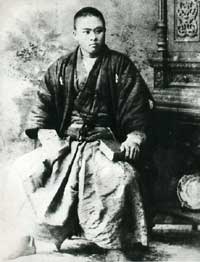
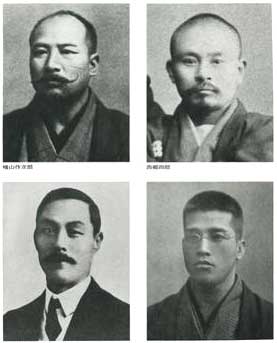
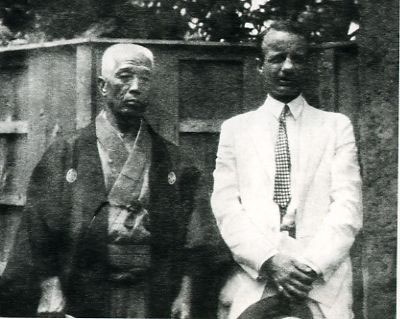
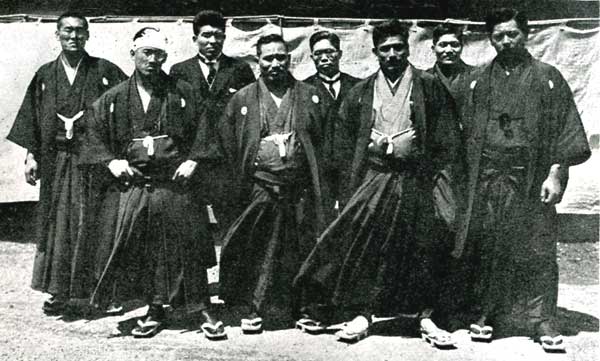



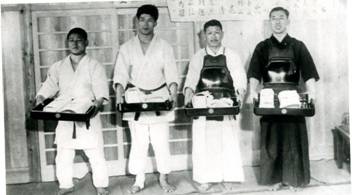

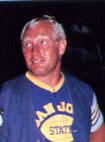 Wilhem Ruska (188 cm, 115 kg) from Holland was one of the greatest post-WWII judokas. He won a gold medal at the 1967 and 1971 World Judo Championship and silver at the 1969 open weight class. Also at the 1972 Olympics held in Munich he won two golds, in each the open and heavyweight classes. He won the heavyweight division by defeating Glahn of W. Germany in 1 min 43 sec with Tai-otoshi. However, in the open weight class Ruska lost his 3rd round match to Kusnezov (USSR) by ura-nage. Through repercharge, Ruska beat Kusnezov by Yokoshiho-gatame, and won the gold medal.
Wilhem Ruska (188 cm, 115 kg) from Holland was one of the greatest post-WWII judokas. He won a gold medal at the 1967 and 1971 World Judo Championship and silver at the 1969 open weight class. Also at the 1972 Olympics held in Munich he won two golds, in each the open and heavyweight classes. He won the heavyweight division by defeating Glahn of W. Germany in 1 min 43 sec with Tai-otoshi. However, in the open weight class Ruska lost his 3rd round match to Kusnezov (USSR) by ura-nage. Through repercharge, Ruska beat Kusnezov by Yokoshiho-gatame, and won the gold medal.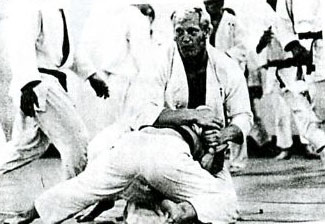
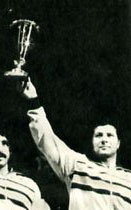
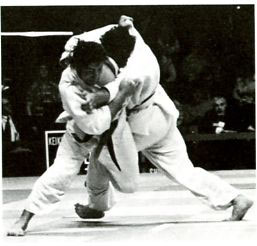
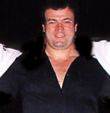 Shota Chochosivili was the first Judoka to win gold for former Soviet Union. In 1972 Olympics, nearly everyone believed that Fumio Sasahara would bring gold for Japan in 93 kg division. Sasahara was two time world champion in 1969 and 1971. He was famous for his excellent Uchi-mata and Harai-gosh. Sasahara met Chochosivili at the second round. Chochoshivili was so strong that Sasahara’s Uchimata was ineffective. Sasahara changed tactics and attacked with Uchimata again, following it with a quick O-uchi-gari scoring Waza-ari. The time was only one minute left when Chochoshivili launched with left Ippon-seo-nage for Ippon. In the final match Chochosivili defeated Starbrook by decision and won the gold medal for USSR.
Shota Chochosivili was the first Judoka to win gold for former Soviet Union. In 1972 Olympics, nearly everyone believed that Fumio Sasahara would bring gold for Japan in 93 kg division. Sasahara was two time world champion in 1969 and 1971. He was famous for his excellent Uchi-mata and Harai-gosh. Sasahara met Chochosivili at the second round. Chochoshivili was so strong that Sasahara’s Uchimata was ineffective. Sasahara changed tactics and attacked with Uchimata again, following it with a quick O-uchi-gari scoring Waza-ari. The time was only one minute left when Chochoshivili launched with left Ippon-seo-nage for Ippon. In the final match Chochosivili defeated Starbrook by decision and won the gold medal for USSR.